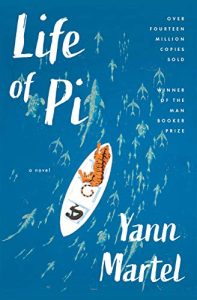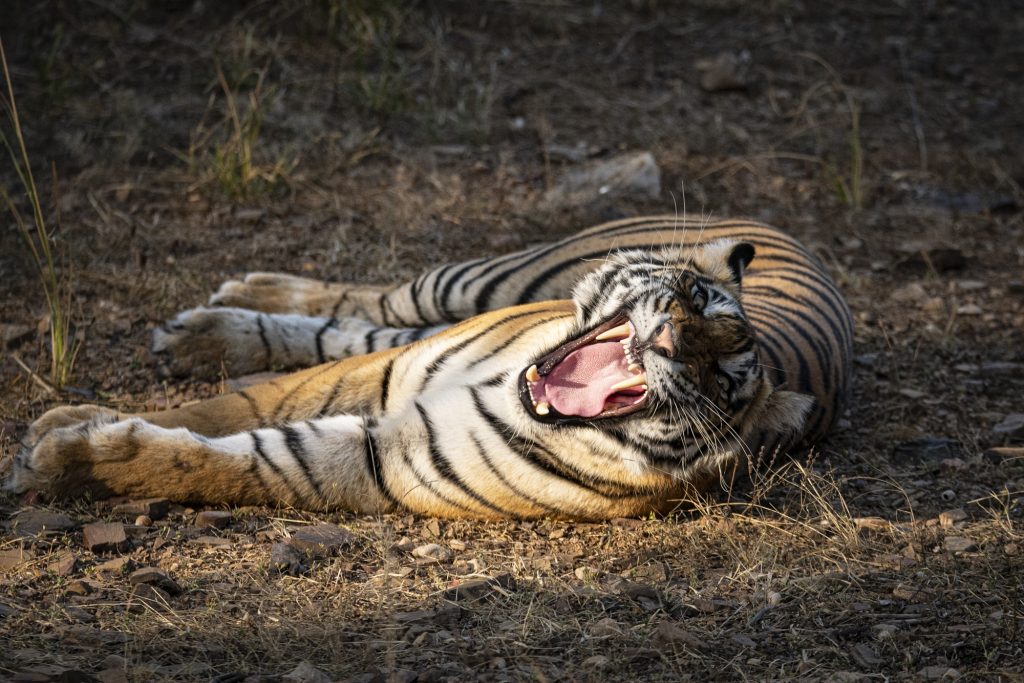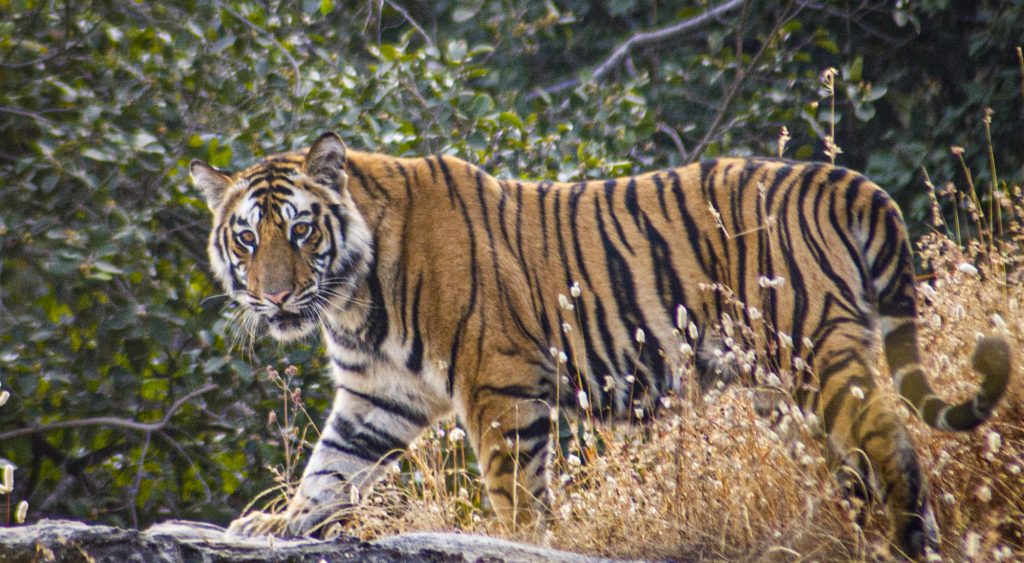Earn Your Stripes This Tiger Day
By Sandra Parmee
26 July 2024
You might not want to invite a tiger for tea, but perhaps you’ve always been curious about this magnificent creature, or have dreamed of someday seeing one in the wild. So grab a cup of tea or coffee and read on to discover what exactly is so captivating about the largest cat species in the world, the troubles they’re facing, and where you might see one for yourself one day.

The Allure of the Tiger
The graceful, majestic tiger has captured the imagination of humanity for centuries. Their distinctive stripes, strong presence, and symbolic resonance across different cultures has led us to tell stories about them for years.
And while they are one of the world’s most powerful predators, this large cat is currently fighting for survival in a changing world.
Tigers in Popular Culture
Tigers are typically symbols of bravery, wisdom and strength, but they’ve been represented in many ways across books, films and other stories.

You may know the famous children’s story, The Tiger Who Came to Tea by Judith Kerr. Published in 1968, the book tells the story of a tiger who invites himself to tea and then eats and drinks all the food and water in the house. This lighthearted tale may have a more sinister meaning, with the tiger representing an underlying threat that robs the family of everything they own, and disrupts the comforting daily routine of a young child.
They can be sources of fear – Shere Khan is a conniving antagonist in Rudyard Kipling’s The Jungle Book, while William Blake described the “fearful symmetry” of the tiger in his 18th century poem.

In Yann Martel’s novel Life of Pi, a young Indian boy named Pi is stranded on a lifeboat in the Pacific Ocean with a Bengal tiger. In this case, the huge cat is said to symbolise Pi’s primal self – the animal instinct that tries to survive against all odds.
Hinduism tells of the goddess Durga riding a tiger into battle, representing unlimited power and the triumph of good over evil.
Famous real-life tigers include the late Siberian tiger, Kenny, known for highlighting the issues of inbreeding in captivity. White tigers, sometimes falsely marketed as an endangered species, are not a separate subspecies of tiger – they are the result of a rare genetic mutation. The most efficient way to breed them is by using tigers with certain recessive genes, and in captive breeding facilities these two tigers are often related, making inbreeding common. Kenny was a tragic victim of this unethical practice.
Then, in 2020, the Tiger King docuseries had millions glued to their screens, watching the antics of private zoo owner Joe Exotic. The show explored the bizarre underbelly of the world of big cat breeding, and whether intentional or not, drew attention to the cruelty of keeping tigers captive in ill-suited environments.
Classification Controversy

The classification of tigers can be a bit confusing. While there were previously believed to be nine subspecies of tiger, with six remaining today, since 2017 the International Union for Conservation of Nature (IUCN) has recognised just two tiger subspecies: the continental tiger and the Sunda island tiger.
Continental tigers
Includes the Bengal, Malayan, Indochinese, and Amur (Siberian) tiger populations. The Caspian tiger, also a continental subspecies, is extinct in the wild, while the South China tiger is believed to be functionally extinct.
Sunda island tigers
Popularly known as the Sumatran tiger, and found only in Sumatra. Sunda island tigers also include the extinct Javan and Bali tigers.

Scientists classified tigers into these subspecies by comparing skull measurements, fur pattern, ecology, and genetics. Some scientists disagree with the classifications, believing that those classified as continental tigers show enough difference genetically to be considered six separate subspecies. It’s an interesting and complex topic, but shouldn’t get in the way of priority number one: saving the tiger from extinction, which is important for so many reasons.
International Tiger Day
Tigers are found in far east Russia, parts of North Korea, China, India, Southwest Asia and the Indonesian island of Sumatra. But the human population has unfortunately encroached on tiger habitats, pushing tigers onto the endangered list.
International Tiger Day, also called Global Tiger Day, is celebrated every year on 29 July, with the purpose of raising awareness about tigers and their endangered status. According to the Global Tiger Forum, as of 2023 there were just 5500 tigers remaining in the wild. Other sources state there are only between 3000 and 4000 remaining. Compare this with the nearly 100,000 that roamed Asia in the 20th century! Today, they enjoy less than 5% of their historical range.
Factors threatening the survival of the tiger are the usual culprits: illegal wildlife trade, human-wildlife conflict, habitat loss and fragmentation and, of course, climate change. Although tigers are a protected species, there is a thriving illegal trade in their body parts. Tiger parts are used for everything ranging from ornamental tiger-skin rugs to traditional medicine products like tiger bone wine.
To be part of the solution, consider learning about more tigers and the particular problems they face, educating others, or donating to WWF to support the great work they do. You can even symbolically adopt a tiger!
A Turning Point for Tigers

In 2010, governments of the world’s 13 tiger range countries came together to create a blueprint for tiger recovery. With increased collaboration between leaders, conservation organisations, donors, and the communities who live in tiger territory, tiger numbers have been slowly ticking upwards in recent years. According to The World Wide Fund for Nature (WWF), tiger populations are stable or increasing in India, Nepal, Bhutan, Russia and China.
Still, we have some way to go if we are to secure the tiger’s future in the wild. In some areas, including much of Southeast Asia, tigers are still in crisis and declining in number.
Tourism infrastructure in their key habitats have been improving, meaning that visitors can be at ease knowing that they are having minimal impact on the animals. Visiting them in the wild is, of course, a much more ethical and sustainable alternative to visiting tigers in captivity.
Where Can I See a Tiger?
Has it always been on your bucket list to see a tiger in the wild? You’re not alone – our CEO Ash Sofat went in search of a tiger recently, and it was a life-changing experience!
India is a great choice if you’re wanting to see one for yourself. According to WWF, around 3700 of the world’s tigers are in India – around 75% of the total population.
Ranthambore National Park in India was home to approximately 88 Bengal tigers as of 2023. Madhya Pradesh is known as India’s ‘Tiger State’ as it’s home to approximately 50 tiger reserves, one of which is Kanha National Park. Kanha is said to be the inspiration for Kipling’s Jungle Book, where virgin forests and rolling landscapes harbour tigers, deer and other natural attractions.
Several of our tours to India offer opportunities to see tigers in the wild.

Somak Tours with Opportunities to Spot Tigers
This 14-night tour takes you on an exciting search for three of the big cats – the Asiatic lion, the leopard, and, of course, the tiger! The tour meanders from Mumbai to Delhi, taking in national parks and sanctuaries where you have the opportunity to spot these majestic creatures as well as a host of other wildlife.
Ganges River Cruise Plus Tigers
On this tour, you’ll spend seven nights on board the Bengal Ganga Ship and explore the rich history of the Gages visiting temples, monuments and palaces along the river. Next, you’ll travel to Kanha National Park for four nights of tiger spotting.
Heritage and Wildlife of Central India
This offers a wonderful mixture of culture and wildlife spread over 14 nights. Explore bustling Delhi, visit lakes, temples and palaces and enjoy game drives in three national parks – Satpura, Kanha and Pench, where you’re likely to see a variety of fascinating creatures including – fingers crossed – the beautiful tiger.

Contact
Somak House
Harrovian Business Village
Bessborough Road
Harrow On the Hill
HA1 3EX
Tel: +44 20 8423 3000
Fax: +44 20 8423 7700
Email: info@somak.com
Opening times
| Mon - Fri | : | 9am to 6pm |
| Sat - Sun | : | Closed |






